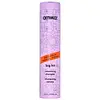What's inside
What's inside
 Key Ingredients
Key Ingredients

 Benefits
Benefits

 Concerns
Concerns

 Ingredients Side-by-side
Ingredients Side-by-side

Alcohol Denat.
AntimicrobialHydrofluorocarbon 152a
Octylacrylamide/Acrylates/Butylaminoethyl Methacrylate Copolymer
Pentapeptide-29 Cysteinamide
Pentapeptide-30 Cysteinamide
Tetrapeptide-28 Argininamide
Tetrapeptide-29 Argininamide
Hydrolyzed Keratin
HumectantCocodimonium Hydroxypropyl Hydrolyzed Keratin
Skin ConditioningThermus Thermophillus Ferment
Skin ConditioningGlycerin
HumectantPrunus Domestica Seed Oil
Skin ConditioningOpal Powder
Skin ConditioningPolyquaternium-69
Tocopheryl Acetate
AntioxidantAminomethyl Propanol
BufferingPEG/PPG-17/18 Dimethicone
EmulsifyingPhenyl Trimethicone
Skin ConditioningPentaerythrityl Tetracaprylate/Tetracaprate
EmollientTriethyl Citrate
MaskingBenzophenone-4
UV AbsorberButylene Glycol
HumectantLimonene
PerfumingLinalool
PerfumingParfum
MaskingAlcohol Denat., Hydrofluorocarbon 152a, Octylacrylamide/Acrylates/Butylaminoethyl Methacrylate Copolymer, Pentapeptide-29 Cysteinamide, Pentapeptide-30 Cysteinamide, Tetrapeptide-28 Argininamide, Tetrapeptide-29 Argininamide, Hydrolyzed Keratin, Cocodimonium Hydroxypropyl Hydrolyzed Keratin, Thermus Thermophillus Ferment, Glycerin, Prunus Domestica Seed Oil, Opal Powder, Polyquaternium-69, Tocopheryl Acetate, Aminomethyl Propanol, PEG/PPG-17/18 Dimethicone, Phenyl Trimethicone, Pentaerythrityl Tetracaprylate/Tetracaprate, Triethyl Citrate, Benzophenone-4, Butylene Glycol, Limonene, Linalool, Parfum
Water
Skin ConditioningSodium C14-16 Olefin Sulfonate
CleansingCocamidopropyl Betaine
CleansingSodium Cocoyl Isethionate
CleansingCocamidopropyl Hydroxysultaine
CleansingPhospholipids
Skin ConditioningNiacinamide
SmoothingPanthenol
Skin ConditioningCaffeine
Skin ConditioningBiotin
AntiseborrhoeicXylitol
HumectantMaltodextrin
AbsorbentRosmarinus Officinalis Extract
AntimicrobialSyringa Vulgaris Extract
Skin ConditioningMentha Piperita Oil
MaskingHippophae Rhamnoides Fruit/Seed Oil
AntimicrobialGlycerin
HumectantCoconut Acid
CleansingEthylhexylglycerin
Skin ConditioningButylene Glycol
HumectantPolyurethane-10
Polyquaternium-7
Polyquaternium-10
Polyquaternium-16
Zea Mays Starch
AbsorbentNatto Gum
Tetrasodium Glutamate Diacetate
Lactic Acid
BufferingTocopheryl Acetate
AntioxidantChlorphenesin
AntimicrobialSodium Chloride
MaskingSodium Phosphate
BufferingSodium Isethionate
CleansingSodium Hydroxide
BufferingSodium Benzoate
MaskingPhenoxyethanol
PreservativeParfum
MaskingBenzyl Benzoate
AntimicrobialHydroxycitronellal
PerfumingLimonene
PerfumingWater, Sodium C14-16 Olefin Sulfonate, Cocamidopropyl Betaine, Sodium Cocoyl Isethionate, Cocamidopropyl Hydroxysultaine, Phospholipids, Niacinamide, Panthenol, Caffeine, Biotin, Xylitol, Maltodextrin, Rosmarinus Officinalis Extract, Syringa Vulgaris Extract, Mentha Piperita Oil, Hippophae Rhamnoides Fruit/Seed Oil, Glycerin, Coconut Acid, Ethylhexylglycerin, Butylene Glycol, Polyurethane-10, Polyquaternium-7, Polyquaternium-10, Polyquaternium-16, Zea Mays Starch, Natto Gum, Tetrasodium Glutamate Diacetate, Lactic Acid, Tocopheryl Acetate, Chlorphenesin, Sodium Chloride, Sodium Phosphate, Sodium Isethionate, Sodium Hydroxide, Sodium Benzoate, Phenoxyethanol, Parfum, Benzyl Benzoate, Hydroxycitronellal, Limonene
Ingredients Explained
These ingredients are found in both products.
Ingredients higher up in an ingredient list are typically present in a larger amount.
Butylene Glycol (or BG) is used within cosmetic products for a few different reasons:
Overall, Butylene Glycol is a safe and well-rounded ingredient that works well with other ingredients.
Though this ingredient works well with most skin types, some people with sensitive skin may experience a reaction such as allergic rashes, closed comedones, or itchiness.
Learn more about Butylene GlycolGlycerin is already naturally found in your skin. It helps moisturize and protect your skin.
A study from 2016 found glycerin to be more effective as a humectant than AHAs and hyaluronic acid.
As a humectant, it helps the skin stay hydrated by pulling moisture to your skin. The low molecular weight of glycerin allows it to pull moisture into the deeper layers of your skin.
Hydrated skin improves your skin barrier; Your skin barrier helps protect against irritants and bacteria.
Glycerin has also been found to have antimicrobial and antiviral properties. Due to these properties, glycerin is often used in wound and burn treatments.
In cosmetics, glycerin is usually derived from plants such as soybean or palm. However, it can also be sourced from animals, such as tallow or animal fat.
This ingredient is organic, colorless, odorless, and non-toxic.
Glycerin is the name for this ingredient in American English. British English uses Glycerol/Glycerine.
Learn more about GlycerinLimonene is a fragrance that adds scent and taste to a formulation.
It's found in the peel oil of citrus fruits and other plants such as lavender and eucalyptus. The scent of limonene is generally described as "sweet citrus".
Limonene acts as an antioxidant, meaning it helps neutralize free radicals.
When exposed to air, oxidized limonene may sensitize the skin. Because of this, limonene is often avoided by people with sensitive skin.
The term 'fragrance' is not regulated in many countries. In many cases, it is up to the brand to define this term. For instance, many brands choose to label themselves as "fragrance-free" because they are not using synthetic fragrances. However, their products may still contain ingredients such as essential oils that are considered a fragrance.
Learn more about LimoneneParfum is a catch-all term for an ingredient or more that is used to give a scent to products.
Also called "fragrance", this ingredient can be a blend of hundreds of chemicals or plant oils. This means every product with "fragrance" or "parfum" in the ingredients list is a different mixture.
For instance, Habanolide is a proprietary trade name for a specific aroma chemical. When used as a fragrance ingredient in cosmetics, most aroma chemicals fall under the broad labeling category of “FRAGRANCE” or “PARFUM” according to EU and US regulations.
The term 'parfum' or 'fragrance' is not regulated in many countries. In many cases, it is up to the brand to define this term.
For instance, many brands choose to label themselves as "fragrance-free" because they are not using synthetic fragrances. However, their products may still contain ingredients such as essential oils that are considered a fragrance by INCI standards.
One example is Calendula flower extract. Calendula is an essential oil that still imparts a scent or 'fragrance'.
Depending on the blend, the ingredients in the mixture can cause allergies and sensitivities on the skin. Some ingredients that are known EU allergens include linalool and citronellol.
Parfum can also be used to mask or cover an unpleasant scent.
The bottom line is: not all fragrances/parfum/ingredients are created equally. If you are worried about fragrances, we recommend taking a closer look at an ingredient. And of course, we always recommend speaking with a professional.
Learn more about ParfumTocopheryl Acetate is AKA Vitamin E. It is an antioxidant and protects your skin from free radicals. Free radicals damage the skin by breaking down collagen.
One study found using Tocopheryl Acetate with Vitamin C decreased the number of sunburned cells.
Tocopheryl Acetate is commonly found in both skincare and dietary supplements.
Learn more about Tocopheryl Acetate